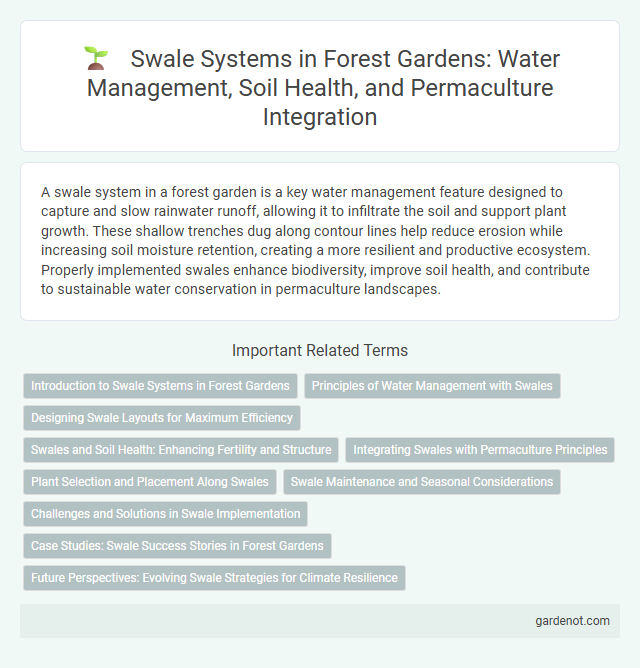A swale system in a forest garden is a key water management feature designed to capture and slow rainwater runoff, allowing it to infiltrate the soil and support plant growth. These shallow trenches dug along contour lines help reduce erosion while increasing soil moisture retention, creating a more resilient and productive ecosystem. Properly implemented swales enhance biodiversity, improve soil health, and contribute to sustainable water conservation in permaculture landscapes.
Introduction to Swale Systems in Forest Gardens
Swale systems are key landscape features in forest gardens designed to capture and manage water runoff efficiently. These shallow, contour-following ditches help promote soil moisture retention, reduce erosion, and enhance groundwater recharge, creating ideal conditions for diverse plant growth. Integrating swales supports sustainable water use and boosts overall forest garden productivity by fostering resilient ecosystems.
Principles of Water Management with Swales
Swale systems enhance forest garden water management by capturing and slowly infiltrating runoff, reducing soil erosion and increasing groundwater recharge. Designed along contour lines, swales distribute water evenly across planting zones, promoting deep soil moisture retention essential for diverse plant growth. These earthworks integrate mulch and vegetation, optimizing microclimates and supporting sustainable ecosystem productivity.
Designing Swale Layouts for Maximum Efficiency
Designing swale layouts for maximum efficiency involves positioning swales along contour lines to optimize water capture and infiltration. Incorporating appropriate dimensions based on slope gradient and soil type ensures effective runoff management and reduces erosion. Strategic planting of deep-rooted vegetation on swale berms enhances soil stability and boosts moisture retention within the forest garden ecosystem.
Swales and Soil Health: Enhancing Fertility and Structure
Swales are key landscape features in forest gardens designed to capture and retain rainwater, reducing erosion and promoting deep soil infiltration. By slowing water runoff and encouraging organic matter accumulation, swales improve soil fertility and enhance microbial activity, leading to healthier soil structure. These benefits support robust plant growth, increased nutrient availability, and long-term ecosystem resilience.
Integrating Swales with Permaculture Principles
Swale systems effectively capture and retain rainwater, enhancing soil moisture and reducing erosion within forest gardens by following permaculture principles of water conservation and earth shaping. Integrating swales supports the creation of microclimates that improve plant growth diversity and yield while promoting natural nutrient cycling through water infiltration. This method aligns with permaculture's emphasis on designing sustainable, self-maintaining ecosystems that optimize resource use and ecological balance.
Plant Selection and Placement Along Swales
Plant selection and placement along swales in a forest garden emphasize deep-rooted, moisture-loving species like willows, alders, and comfrey to stabilize soil and enhance water retention. Position nitrogen-fixing plants such as clover and lupines strategically to enrich soil fertility within swale boundaries. Incorporate a diverse mix of native shrubs, herbs, and groundcovers in layers to maximize biodiversity, prevent erosion, and support beneficial microbial activity in the swale ecosystem.
Swale Maintenance and Seasonal Considerations
Swale maintenance involves regular inspection to prevent erosion, clear debris, and ensure proper water infiltration, which supports healthy forest garden growth. Seasonal considerations include adjusting swale edges before rainy seasons to maximize water capture and avoid overflow, while mulch application during dry periods retains soil moisture. Proper upkeep enhances soil fertility and plant health by maintaining consistent moisture levels and preventing nutrient loss.
Challenges and Solutions in Swale Implementation
Swale implementation in forest gardens often faces challenges such as soil erosion, inadequate water retention, and poor placement leading to ineffective runoff capture. Solutions include careful site analysis to position swales along contour lines, using organic mulch to reduce erosion, and integrating deep-rooted plants to enhance soil structure and water infiltration. Regular maintenance and adaptive modifications based on seasonal water flow assessments further improve swale performance and long-term sustainability.
Case Studies: Swale Success Stories in Forest Gardens
Swale systems have proven highly effective in forest gardens by enhancing water retention and soil fertility, as demonstrated in Mark Shepard's New Forest Farm and Patrick Whitefield's forest garden projects. These case studies highlight how swales reduce erosion and support diverse plant growth, creating resilient ecosystems that require minimal irrigation. Data shows swale-integrated forest gardens yield higher fruit and nut production while improving biodiversity and carbon sequestration.
Future Perspectives: Evolving Swale Strategies for Climate Resilience
Emerging swale systems integrate advanced water retention techniques and native vegetation to enhance soil moisture and biodiversity in forest gardens, addressing climate variability. Innovations in swale design, such as adaptive contouring and bioengineering, improve resilience to extreme weather events and promote groundwater recharge. Future strategies emphasize scalable, community-driven approaches that align with ecosystem dynamics to sustain forest garden productivity and ecological balance.
Swale system Infographic

 gardenot.com
gardenot.com